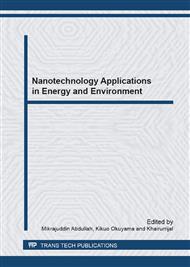[1]
S.K. Maity, J. Ancheyta, G. Marroquín, Catalytic Aquathermolysis for Viscosity Reduction of Heavy Crude Oils: A Review, Energy Fuel 24 (2010) 2809-2816.
DOI: 10.1021/ef100230k
Google Scholar
[2]
Y. Wang, Y. Chen, J. He, P. Li, C. Yang, Mechanism of Catalytic Aquathermolysis: Influences on Heavy Oil by Two Types of Efficient Catalytic Ions: Fe3+ and Mo6+, Energy Fuel 24 (2010) 1502-1510.
DOI: 10.1021/ef901339k
Google Scholar
[3]
W. Li, J-H. Zhu, J-H. Qi, Application of Nano-nickel Catalyst in The Viscosity Reduction of Liaohe Extra-Heavy Oil by Aquathermolysis, J. Fuel Chem. Technol. 35 (2007) 176-180.
DOI: 10.1016/s1872-5813(07)60016-4
Google Scholar
[4]
Y. Liu, H. Fan, The Effect of Hydrogen Donor Additive on the Viscosity of Heavy Oil during Steam Stimulation, Energy Fuel 16 (2002) 842 – 846.
DOI: 10.1021/ef010247x
Google Scholar
[5]
N.N. Nassar, A. Hassan, P. Pereira-Alma, Application of Nanotechnology for Heavy Oil Upgrading: Catalytic Steam Gasification/Cracking of Asphaltenes, Energy Fuel 25 (2011) 1566-1570.
DOI: 10.1021/ef2001772
Google Scholar
[6]
D.J. Seo, S.B. Park, Y.C. Kang, K.L. Choy, Formation of ZnO, MgO, and NiO Nanoparticles from Aqueous Droplets in Flame Reactor, J. Nanopart. Res. 5 (2003) 199–210.
Google Scholar
[7]
M.M.K. Motlagh, A.A. Youzbashi, L. Sabaghzadeh, Synthesis and Characterization of Nickel Hydroxide/Oxide Nanoparticles by the Complexation-precipitation Method, J. Phys. Sci. 6 (2011) 1471-1476.
Google Scholar
[8]
I.W. Lenggoro, Y. Itoh, N. Iida, K. Okuyama, K. Control of Size and Morphology in NiO Particles Prepared by a Low-pressure Spray Pyrolysis, Mater. Res. Bull. 38 (2003) 1819–1827.
DOI: 10.1016/j.materresbull.2003.08.005
Google Scholar
[9]
D. Ai, X. Dai, Q Li, C. Deng, S. Kang, S. Synthesis of NiO Nanoparticles in Ethylene Glycol, China Particuology 2 (2004) 157-159.
DOI: 10.1016/s1672-2515(07)60047-5
Google Scholar
[10]
X. Cao, Y. Xu Yanjuna, N. Wang, Facile Synthesis of NiO Nanoflowers and Their Electrocatalytic Performance, Sensor Actuat. B-Chem. 153 (2011) 434–438.
Google Scholar
[11]
L. Zhang, L. An, B. Liu, H. Yang, Synthesis and Photocatalytic Activity of Porous Polycrystalline NiO Nanowires, App. Phys. A. 104 (2011) 69-75.
DOI: 10.1007/s00339-011-6403-3
Google Scholar
[12]
H. Yang, Y. Hu, A. Tang, S. Jin, G. Qiu, Synthesis of Tin Oxide Nanoparticles by Mechanochemical Reaction, J. Alloys Compd. 363 (2004) 271-274.
DOI: 10.1016/s0925-8388(03)00473-0
Google Scholar


